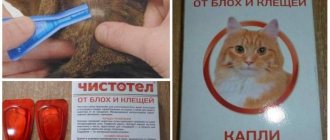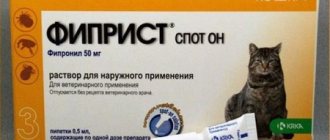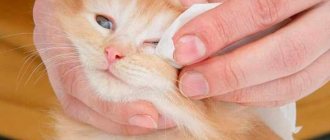The safety of a pet worries every concerned owner, so when choosing a means of protection, many people have a lot of questions: effectiveness, duration, principle of operation, ease of use, etc. And today we propose to consider one of the most popular options for protection against annoying parasites - anti-tick drops for cats on the withers. Today they are used quite actively and have mostly positive reviews.
Drops for cats against ticks
Many cat owners prefer this method of preventing tick bites. It is enough to apply drops to the cat’s withers area once a month on average, and the animal will receive long-term comprehensive protection not only from ticks, but also from most external and internal parasites.
The main thing is to spread the fur well so that the active substance gets directly onto the skin, then it will work correctly and fully, exterminating ticks that have fallen on the pet.
The mechanism consists of absorption, further distribution of the product throughout the subcutaneous layer and its accumulation in the sebaceous glands and hair follicles. When the parasite tries to bite a cat, the cat receives a poisonous dose of the substance and quickly dies before it can harm the animal.
As a rule, anti-tick drops for cats usually contain acaricides and insecticides in their original composition, but can also be developed based on plant components - natural killers of bloodsuckers. The latter can be used with virtually no restrictions on the age and condition of the cat.
Popular and high-quality drops, which have demonstrated excellent protective results in practice, are always recommended by veterinarians first.
- The FiproGuard MAX series of products from the American veterinary company Sentry is based on a duo of insecticides - fipronil and etofenprox. In 5 minutes it guarantees the death of the parasite that gets on the cat. Suitable for kittens from 3 months and adult animals. The active result is limited to 1 month, then repeated treatment is required.
- Another series of the same company, PurrScriptions, contains other substances - etofenprox and pyriproxyfen, which help protect the cat from eggs and larvae of parasites, as well as from mosquito bites. Similarly, they can be used only when the kitten reaches the age of 3 months.
- The French products Frontline are known for their high-quality protection against parasites, drops of which kill mites more slowly, but kill all mites, even internal scabies, as well as their eggs. In addition to tick bites, they protect cats from fleas, lice, lice, and chelitis.
- In terms of characteristics and reviews, it is not inferior to any of the anti-tick medications for cats from the German manufacturer Bayer. Their line is quite extensive; you can find and select drops for a pet with any characteristics and needs. Their “Advocate” series products are especially famous, helping against internal parasitic infestations.
- A much more affordable, but no less effective drug is the domestic “Bars” drops, which prevent attacks from ticks of any kind, and also additionally work against fleas, lice, and lice. The active effect lasts a month, then the treatment must be repeated.
- Separately, there are drops based on plant components that have destructive and parasite-repellent properties. Such products, for example Vitomax Eco, are absolutely harmless to pets, so they can be applied to a nursing cat, to kittens under 2 months old, to elderly and sick cats.
Important! During the season of special tick activity, it is better not to interrupt the series of drop treatments, but to repeat them monthly, otherwise the animal may become vulnerable just at the moment of a tick bite!
Precautionary measures
Despite the fact that all drugs are recommended as safe, we should not forget that their main components belong to potent antiparasitic agents and are classified as hazard class III.
Precautions to be observed:
- Do not exceed the dosage; symptoms of intoxication are possible: trembling, vomiting, drooling, weakness.
- It is dangerous if the drops get into the cat’s mouth; the symptoms may be the same as those listed above.
- You should not pet a cat, especially in the first 48 hours, much less allow children to do so.
- Try not to breathe these substances to avoid poisoning.
- After handling ticks, you should wash your hands thoroughly.
- It is prohibited to smoke, eat or drink while applying the drops, as residues of the drug remain on the hands.
- The medicine should be kept out of the reach of children and animals.
- Given the toxicity of droplets, containers containing medications are disposed of immediately after use.
- Medicines for ticks are poisonous to other pets: fish, rabbits.
Your veterinarian will help you choose a high-quality and safe product for treatment and protection against ticks.
Sprays to protect cats from ticks
Another popular, and according to some reviews, the most effective method of combating parasite attacks among cat owners is treating the fur with a spray. This measure allows you to protect the places on the body of cats that are most often exposed to tick bites - the stomach, groin, and areas under the tail.
Preventive protection sprays are usually based on a complex of active substances designed to eliminate any parasitic threat, and in addition they care for the coat, making it easier to comb and visually improving its appearance and condition.
The only disadvantage that this drug has is the short period of protective effect, not exceeding 2 weeks. But one cylinder, which is expensive for the owner, is enough for a couple of dozen treatments, that is, for at least 2 seasons.
Here the leaders in the production of sprays are foreign famous brands Sentry, Bayer, Frontline. Sprays are produced in aerosol cans or in containers with a spray bottle.
- They are easy to use - just spray the product from a distance of 25 - 30 cm from the fur against its growth, avoiding contact with the muzzle, mucous membranes, genitals, eyes and ears. The wool needs to be lifted and the liquid allowed to wet it thoroughly so that the substance gets onto the skin. The animal must not be wiped! You can dry the fur with a hairdryer or let it dry naturally.
- Small kittens under 3 months of age are not usually treated with sprays. For adult animals with special needs, you should consult your veterinarian. Some sprays can be sprayed on sick, weakened or elderly cats.
- But the owner who carries out the treatment requires some precautions - do not inhale the drug and avoid getting the substance into the eyes and mouth.
- A wet pet will have to be removed from children or other animals living in the family while it dries.
Important! If there is an aquarium in the house, then spraying cannot be done in this room - all the fish will die! This also applies to birds!
Collars to protect cats from tick bites
This is a protective method for lazy cat owners - put on a collar and for a long time, at least 3 months, forget about the problem of parasites and the negative consequences that infection with them entails.
The insectoacaricidal drug with which such a collar is impregnated has a prolonged release property and thereby kills ticks and other ectoparasites for a long time. However, this method of protection does not provide a 100% guarantee. Some cat owners additionally treat their pets with a spray, especially before going out into nature, to the country, or on vacation.
Collars are produced by many companies, and according to reviews from veterinarians, they work very effectively in accordance with their declared properties. Such a collar can completely protect an ordinary city and even rural cat. The only exceptions will be animals located in areas where ticks are rampant.
Putting on a protective collar is quite simple, the main thing is to follow simple rules and precautions.
- Open the package before putting it on to prevent the substances from escaping.
- Adjust the size so that the pet is comfortable, and at the same time so that the collar does not dangle around the neck. It is optimal to leave 1 finger of slack, cut off the rest of the tape and discard.
- If there are other pets or small children in the house, then you should not allow anyone to chew, lick or simply taste the collar - this can lead to poisoning!
- Since this is contact protection, at first it is better to check the cat’s neck to see if there is any irritation. If alarming signs appear, the collar should be removed, which means it is not suitable for the cat.
Important! In order for your pet to be constantly protected, the collar must be changed on time - its active period is indicated on the packaging.
Why do cats need tick prevention?
More than once the opinion has been heard that cats are not afraid of tick attacks, especially single ones. This is true exclusively for piroplasmosis, which really does not threaten cats to the same extent as dogs and farm livestock.
Otherwise, cats should beware of ticks due to all other negative consequences, because piroplasmosis is not the only one of them.
Completely domestic cats that do not practice self-walking and spend their entire cat life within the confines of a human home or apartment are not at all immune from tick attacks.
For example, ixodid parasites can easily get into an apartment on the clothes or shoes of the owners themselves, who bring them directly from the street. Because the bloodsucker, having caught on the edge of clothing in the grass, is able to wander around the body for about an hour to find a place convenient for penetration.
In the same way - from the street - individuals of small mites that parasitize the body of mammals and humans and cause scabies of various localizations enter the apartment.
Therefore, damage to the health of cats and its severity depend on the type of tick that bit the animal.
- An ixodid tick has temporarily burrowed in to drink its fill of cat blood and then fall off.
- Scabies mite, which has entered for lifelong parasitism and reproduction in the cat’s body.
Serious health problems in cats after a tick bite can manifest in a variety of ways. It depends on the classification of the parasite and the infection it can infect the bitten cat with.
Therefore, a drug for treating the consequences of a tick bite is selected based on symptoms, tests and the resulting diagnosis. But the preventive agent is universal - it will protect the cat from attacks by any ticks, and as a plus - from fleas, lice, lice and other ectoparasites.
Important! Diseases caused by tick-borne attacks of any type of parasite are called acariasis. These are tick-borne infections that are dangerous not only for domestic and wild animals, but also for humans. Some are even deadly!
Features of application and composition
Experts recommend using anti-tick drops for cats during periods of maximum tick activity. Applying such products is quite simple: spread the fur at the withers and apply the product. The application site must be chosen so that the animal cannot reach it with its tongue and will not lick off the insecticide.
After applying the drug, hands should be washed with soap. Do not touch the treatment area for 24 hours. The animal should not get wet (get caught in the rain or swim) for 24 hours after treatment. In addition, it is not recommended to bathe the cat three days before applying the product.
The composition of antiparasitic agents may include the following substances:
- Permethrin. Safe for warm-blooded animals.
- Invermectin. If the exact dosage is observed, it is safe for pets.
- Fipronil. Prevents re-infection.
- Methoprene. Growth regulator. Disturbs the development of insects at the egg stage.
- Imidacloprid. Causes paralysis and death of insects.
- Pyriproxyfen. For a long time it was used exclusively for impregnation of flea collars. It is now used to produce other products.
- Diflubenzuron. Destroys parasite larvae, has no effect on adults.
The duration of the repellent effect for most drops is four weeks. During the period of peak tick activity, veterinarians advise treating animals more often, once every three weeks. The dosage of the drug is not exceeded.
What are the dangers of blood-sucking ixodid parasites for cats?
Bloodsuckers of the ixodic family, in addition to piroplasmosis, which does not threaten cats, actually transmit a lot of vector-borne diseases - about 200 forms! Ticks are carriers and distributors of various pathogens, which, when they pierce the skin layer with tick saliva, enter the victim’s body:
- pathogenic bacteria;
- dangerous viruses;
- parasitic rickettsia;
- harmful protozoa;
- helminths that undermine health.
In addition to these misfortunes, ixodid bloodsuckers are dangerous for cats by transmitting dermatobiasis, a dangerous infection caused by the penetration of gadfly larvae under the skin and causing severe suppuration. Any antibiotic is powerless against such subcutaneous abscesses - the pathogen is removed only surgically, cutting out along with the infiltrate. And then numerous, difficult to heal cuts remain along with scars that disfigure the pet.
But even with piroplasmosis, not everything is smooth for cats! In recent years, there have been cases of registration of cats in which Babesia, the causative agent of this deadly infection for animals, was detected in their blood. And although this is isolated data, it doesn’t hurt to be wary. This infection is not difficult to treat, and you can choose an effective drug, the main thing is to recognize the disease in the first 2 - 3 days, otherwise irreversible processes begin.
You should not miss the toxicity of the saliva of some ticks for cats, which sometimes causes specific poisoning:
- stiffness of the cat’s movements due to pain in muscles and joints;
- lethargy and refusal to feed;
- vomiting and stool disorders;
- increased body temperature in a cat;
- the appearance of a rash with or without itching;
- inappropriate pet behavior.
In many cats, mite saliva causes allergy attacks, which manifest themselves differently in each cat, from swelling and shortness of breath to dermatitis and even the appearance of bald spots. To neutralize allergic manifestations, any antihistamine is used, and in the presence of complications, symptomatic therapy is added.
Application procedure
The main indications for prescribing Amit drops to cats are sarcoptic mange, demodicosis, notoedrosis and cheyletiosis. The solution is used according to the following scheme:
- Clean the affected areas of the body from crusts and scabs.
- The drops are evenly distributed over the site of the disease, covering up to 10 mm of healthy skin (treatment is carried out from the periphery to the central part).
- A cervical collar is put on the cat for 20 minutes to prevent licking of the drug.
The animal is treated with the drug 2 to 5 times at weekly intervals. A single dose of the drug is calculated based on the ratio of 0.5 ml per kilogram of the pet’s weight. In case of extensive skin damage, Amit is applied to problem areas in two doses (first on one half of the body, and a day later on the other). The basis for discontinuing the medication is the clinical recovery of the pet, confirmed by two negative laboratory results.
An additional indication for the use of Amita is otodectosis (ear scabies) in cats. The drug is used according to the following algorithm:
- Clean the animal's external auditory canal from dirt.
- Fix the cat's head to prevent splashing of the solution.
- Instill 3 drops of medicine into each ear canal (even in the case of unilateral otodectosis).
- Fold your pet's ears in half and lightly massage them at the base for a minute.
Treatment of the ear canals is carried out twice with an interval of 8-10 days. When a secondary infection occurs, the treatment regimen includes the use of anti-inflammatory, immunomodulatory and antibacterial drugs.











